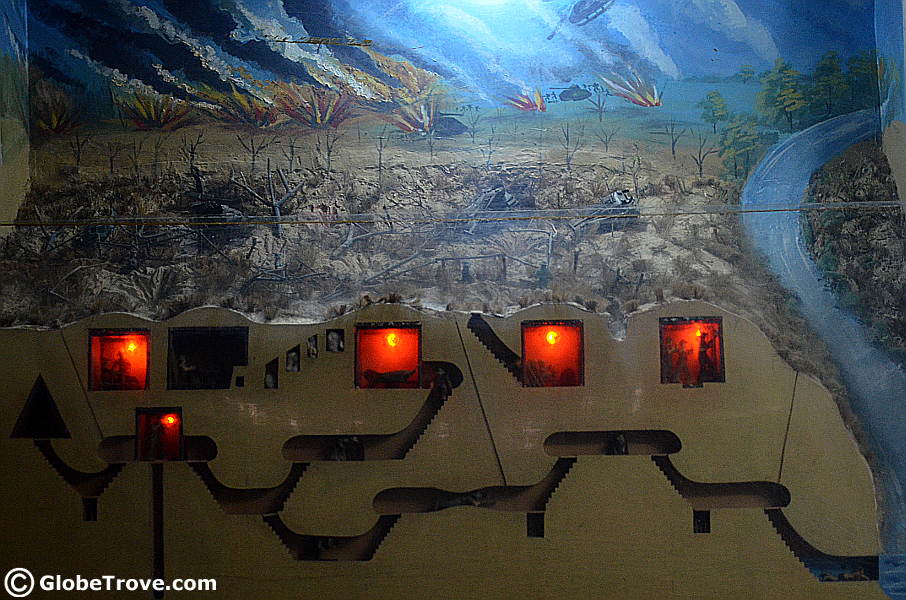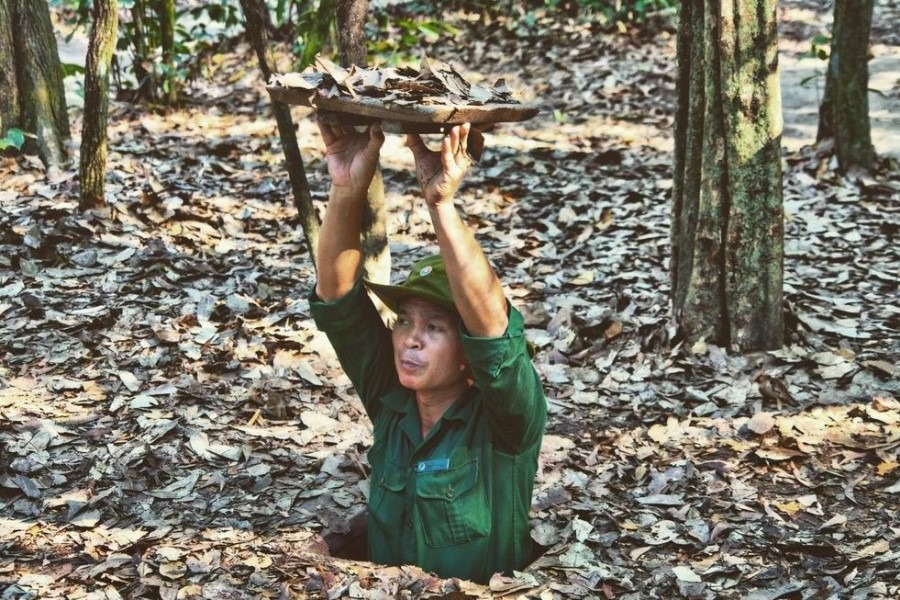Table of Contents
What are the cu chi tunnels? Venturing into the depths of the Cu Chi Tunnels is akin to embarking on a historical odyssey, retracing the footsteps of Vietnamese resilience, innovation, and unwavering determination. These subterranean labyrinths, etched into the earth’s bowels, stand as silent sentinels, bearing witness to the tumultuous saga of the Vietnam War. Delving into their depths unveils a poignant narrative of human endurance, strategic brilliance, and the indomitable spirit of a nation united against adversity.
History of the Cu Chi Tunnels

The Cu Chi Tunnels, a sprawling subterranean network spanning over 200 kilometers, emerged as a response to the escalating American military presence in South Vietnam during the Vietnam War. The people of Cu Chi, a rural district located just northwest of Saigon (now Ho Chi Minh City), ingeniously conceived these tunnels as a means of survival, defense, and retaliation. Their construction commenced in the early 1940s, initially serving as a refuge for villagers seeking shelter from French colonial forces. However, as the conflict with the United States intensified, the tunnels evolved into a sophisticated underground fortress.
Purpose and Construction of the Cu Chi Tunnels
The Cu Chi Tunnels served a myriad of purposes, each vital to the survival and resistance efforts of the Vietnamese people. They were used as hiding spots, communication and supply routes, living quarters, and even weapons storage. The tunnels were constructed by hand using primitive tools such as shovels, hoes, and bamboo picks. The soil was removed and carried away in baskets, then dispersed in nearby fields to avoid detection. The tunnels were dug in three levels – the upper level for ventilation and escape routes, the middle level for living quarters, and the lower level for storage and combat.
The construction of the tunnels was a labor-intensive and dangerous process, as the builders had to work in secrecy while constantly under threat of American airstrikes and ground attacks. Despite these challenges, the Vietnamese people managed to expand and improve the tunnels over time, making them an integral part of their resistance strategy.
Layout and Features of the Cu Chi Tunnels
What are the cu chi tunnels were a complex network of underground passages, with some sections stretching up to three levels deep. The tunnels were designed with various features to aid in their function and defense. These included trapdoors, camouflaged entrances, booby traps, and air vents disguised as termite mounds or anthills. The tunnels were also equipped with kitchens, hospitals, and command centers, showcasing the ingenuity and resourcefulness of the Vietnamese people.
Life in the Cu Chi Tunnels during the Vietnam War

Life in the Cu Chi Tunnels was harsh and grueling, with cramped living conditions, poor ventilation, and constant fear of enemy attacks. The tunnels were home to thousands of Vietnamese soldiers and civilians, who had to endure long periods of time underground without access to sunlight or fresh air. Food and water were scarce, and diseases such as malaria and dysentery were rampant. Despite these challenges, the people of Cu Chi persevered and used the tunnels as a base for launching surprise attacks on American forces.
Daily Routine in the Cu Chi Tunnels
The daily routine in What are the cu chi tunnels was highly regimented, with strict schedules for sleeping, eating, and working. Soldiers and civilians would often spend up to 18 hours a day in the tunnels, only emerging at night to tend to crops or engage in combat. Meals were simple and consisted mainly of rice, vegetables, and occasional meat from captured animals. Cooking was done in small, makeshift kitchens using firewood or charcoal, which posed a constant risk of detection by American forces.
Challenges and Dangers in the Cu Chi Tunnels
Life in the Cu Chi Tunnels was not without its dangers. The tunnels were infested with insects, snakes, and rats, which posed a constant threat to the inhabitants. The cramped living conditions also led to frequent injuries and illnesses, with little access to medical care. Moreover, the constant threat of American airstrikes and ground attacks meant that the people of Cu Chi had to be constantly on guard and ready to evacuate at a moment’s notice.
Strategic Importance of the Cu Chi Tunnels

The Cu Chi Tunnels played a crucial role in the Vietnamese resistance efforts during the Vietnam War. They provided a safe haven for soldiers and civilians, allowing them to evade American forces and launch surprise attacks. The tunnels also served as a communication and supply network, enabling the movement of troops and resources between different parts of the country. Additionally, the tunnels were used to store weapons and ammunition, providing the Vietnamese with a strategic advantage over their enemies.
Impact of the Cu Chi Tunnels on the Vietnam War
The Cu Chi Tunnels were a significant factor in the eventual victory of the Vietnamese people over the United States in the Vietnam War. The tunnels allowed the Vietnamese to sustain their resistance efforts and inflict heavy casualties on American forces. They also played a crucial role in the Tet Offensive of 1968, where the Vietnamese launched a series of surprise attacks on American bases and cities, catching them off guard and causing significant damage. The resilience and determination displayed by the people of Cu Chi in the face of adversity became a symbol of the Vietnamese spirit and inspired others to join the resistance efforts.
Current State and Preservation of the Cu Chi Tunnels

Today, only a small section of the original Cu Chi Tunnels is open to the public, with most of the network remaining inaccessible or destroyed. However, efforts have been made to preserve and restore the tunnels, allowing visitors to experience a glimpse of what life was like underground during the Vietnam War. The tunnels have been reinforced and widened to accommodate tourists, and some sections have been fitted with electric lighting for easier navigation.
Visiting the Cu Chi Tunnels: What to Expect
Visitors to the Cu Chi Tunnels can expect a unique and immersive experience as they explore the underground network. A guided tour will take you through the various features and functions of the tunnels, providing insight into the daily life of the Vietnamese people during the war. Visitors can also try their hand at crawling through some of the narrow passages and even fire weapons used during the conflict. It is recommended to wear comfortable clothing and shoes, as well as bring insect repellent and a flashlight for the tour.
Facts and Figures about the Cu Chi Tunnels
- The Cu Chi Tunnels were first discovered by American forces in 1966.
- At its peak, the tunnel network housed over 16,000 people.
- The tunnels were used to transport supplies and troops between North and South Vietnam.
- The tunnels were also used as a base for launching attacks on American bases and cities.
- The tunnels were equipped with booby traps, including spike pits, bamboo spikes, and tripwires.
- The tunnels were so well camouflaged that American soldiers often walked right over them without realizing.
- The average height of the tunnels was only 1 meter, making it difficult for American soldiers to navigate.
Controversies Surrounding the Cu Chi Tunnels

Despite their historical significance, the Cu Chi Tunnels have also been a subject of controversy. Some critics argue that the tunnels have been overly commercialized and romanticized, with little mention of the atrocities committed by both sides during the war. Others believe that the tunnels have been used as propaganda by the Vietnamese government to glorify their role in the conflict. However, for many visitors, the Cu Chi Tunnels serve as a reminder of the human cost of war and the resilience of the Vietnamese people.
Conclusion

What are the cu chi tunnels stand as a testament to the ingenuity, determination, and sacrifice of the Vietnamese people during the Vietnam War. They offer a unique perspective on the conflict and provide insight into the daily struggles and triumphs of those who lived and fought underground. Visiting the Cu Chi Tunnels is not just a journey through history but also a journey of self-reflection and appreciation for the resilience of the human spirit.